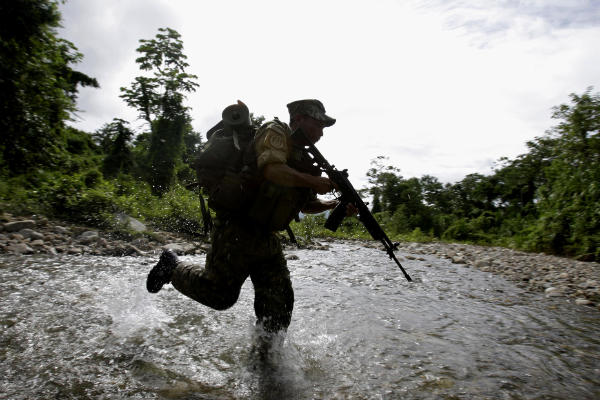
(above) In this file photo taken April 23, 2009, a police officer patrols in an effort to combat drug trafficking and Shining Path insurgents in Canaire in Peru's Apurimac Valley.
Photo: Martin Mejia/AP
In fight with Shining Path, Peru's President Humala takes a page from Colombia
August 16, 2011 - Christian Science Monitor
Peru's new president has vowed to take a hard line against the country's Shining Path guerrillas, and appears to have modeled his strategy on Colombia's counterinsurgency successes.
By Geoffrey Ramsey, Guest blogger
Within days of taking office, Peru's President Ollanta Humala called on the country's armed forces to step up efforts against the Shining Path (Sendero Luminoso). In an Aug. 3 speech to commanders of the Peruvian Armed Forces, Army, Navy, Air Force, and National Police, the president called for a radical shift in strategy in the fight against the rebel group. He singled out the embattled Apruimac and Ene Valley region (VRAE), which is the major hotspot of rebel activity in Peru.
President Humala, himself a former army major, had stern words for the military leadership. "Security starts with the results. The country will feel safe if its armed forces manage to defeat the enemy. But what we see now is that the enemy is in the same place as always, striking any time it wants. That must end," Mr. Humala told the commanders. He then said he would provide military forces in the VRAE region with the resources they needed to finally rout the guerrillas, but that this would be conditional on results.
It appears that Humala has also been encouraging the military to reshape its counterinsurgency strategy. As a La Republica report reveals, the Military Intelligence Wing (Arma de Inteligencia del Ejercito) of the Peruvian army has studied the recent success of Colombia in beating back the Revolutionary Armed Forces of Colombia (Fuerzas Armadas Revolucionarias de Colombia - FARC), specifically their deadly strikes against rebel leaders like Luis Edgar Devia Silva and Víctor Julio Suarez Rojas, better known as "Raul Reyes" and "Mono Jojoy." Intelligence work was a key factor in both of these assassinations, and military sources told the newspaper that they are restructuring their intelligence organs to focus on taking out the Shining Path's leaders in the VRAE.
As La Republica reports, the Colombian military has two brigades assigned to intelligence work: a general military intelligence brigade, which is composed of 11 battalions (which typically comprise 300 to 1,000 men) and a counterintelligence brigade, which consists of five battalions. Peru's military intelligence system, on the other hand, is made up of only a single brigade, consisting of two battalions.
In the coming months, the Peruvian military will introduce at least two more battalions. One has reportedly already been set up, designed to focus specifically on counterintelligence.
With this restructuring, the Peruvian military hopes to make real progress in its campaign against the Shining Path, which has faltered in recent years. As InSight Crime has noted, despite the claim by the outgoing government to have reduced the rebels' "area of influence" from 34,000 to 5,000 square kilometers, coca cultivation statistics indicate that drug production is on the rise in the rebel heartland. According to the United Nations Office on Drugs and Crime (UNODC), the amount of land under coca cultivation in the VRAE has gone up more than 30 percent since 2005, to at least 19,700.
The military has not captured or killed a senior Shining Path leader in the past five years, although the authorities recently arrested the girlfriend of Florindo Eleuterio Flores Hala, alias "Comrade Artemio," who commands the Shining Path faction in the Upper Huallaga Valley, the rebels' other main operations base after the VRAE.
Still, it should be noted that the Peruvian and Colombian security situations are very different in terms of scale. While the total number of rebels in Colombia is estimated at around 10,000, the US State Department says that the number of Shining Path in the country is only around 300.
Additionally, the Shining Path poses a different type of security challenge than the FARC. The threat comes far more from their involvement in the drug trade than their revolutionary ambitions. The Colombian rebels have the cash and manpower to pose a serious military threat to the authorities, though this has declined sharply in the last decade. This allows them to dominate some parts of the country, and attract recruits, in a way the Shining Path cannot.
Because of this, it is not clear that a security strategy based on Colombia's experience can be applied in the Peruvian case. Humala may have better luck by focusing on social factors, which account for the Shining Path's continued existence, namely: spending more on alternative crop measures and economic opportunities for those living in the rebels' areas of influence.
--- Geoffrey Ramsey is a writer for Insight – Organized Crime in the Americas, which provides research, analysis, and investigation of the criminal world throughout the region.